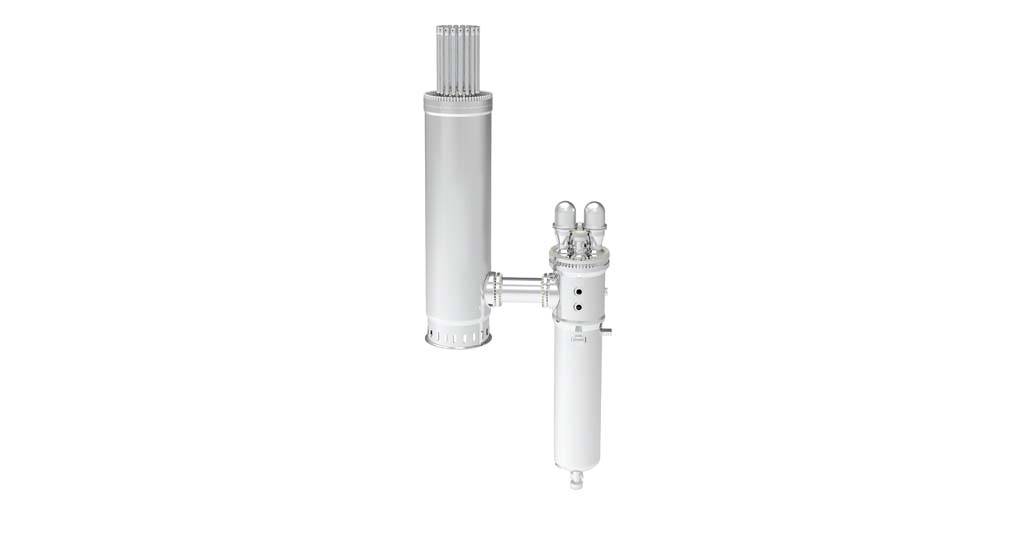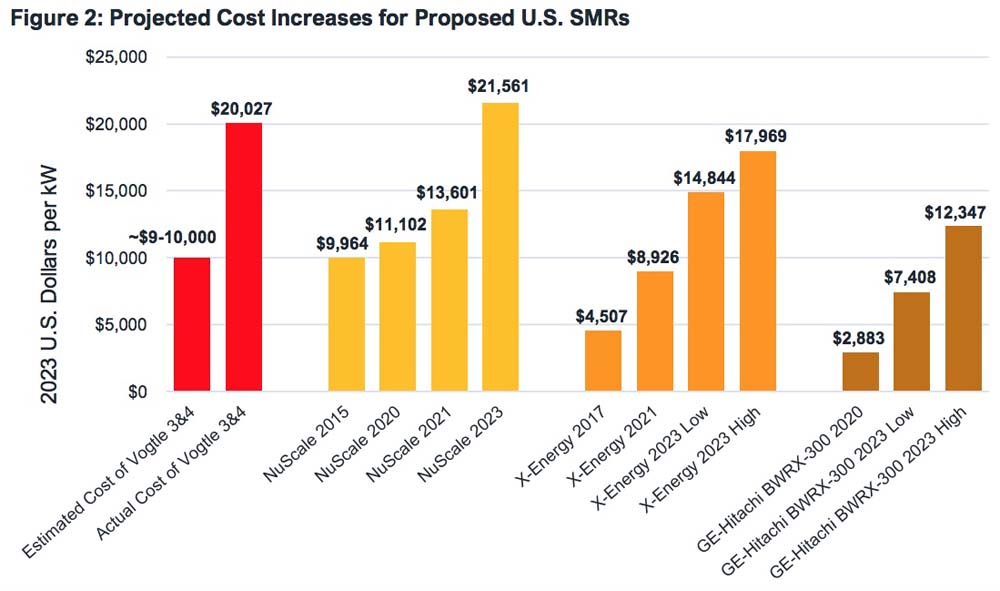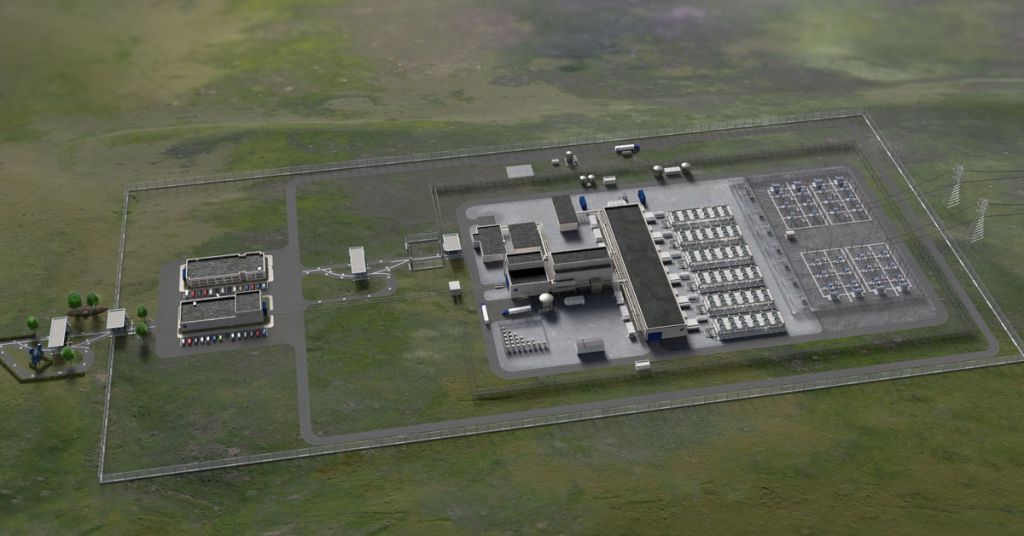The company is investing in small nuclear reactors to power big data generators in eastern Oregon

Power packed: According to X-Energy, its Xe-100 is an 80 MWe reactor that can be scaled into a “four-pack” 320 MWe power plant with a modular design. Image: X-Energy
By Kendra Chamberlain. November 5, 2024. Amazon announced an agreement with Energy Northwest, a consortium of 29 utilities in Washington, to build four small nuclear reactors (SMRs) at the Columbia Generating Station in Richland, Washington.
The four reactors will be built by Maryland-based X-Energy and generate 320 MW of energy by the early 2030s.
Amazon will be the primary customer of that power, and likely use it to power its data centers located in eastern Oregon, according to OPB.
Oregon state law prevents building new nuclear energy generation in the state without voter approval. The new SMR project would be located next to Energy Northwest’s existing nuclear generation plant near the Columbia River.
SMRs are touted by the nuclear industry as a better way to deploy “clean” energy across the United States to help transition the nation’s grids off fossil fuels. SMRs have much lower associated greenhouse gas emissions.
Still, the reactor design has struggled to gain a foothold in the United States.
Amazon recently led a $500 million investment round in X-Energy, which CEO J. Clay Sell told CNBC proved to be a boon for the burgeoning SMR industry.
“The biggest gaping hole we had to fill was the capital to build new projects,” said Sell. “Amazon stepping up and saying we will provide the capital, hundreds of millions of dollars to construct these projects and get them online, that’s one of the most transformative announcements our sector has seen.”
Energy Northwest said it’s been interested in X-Energy’s reactors since 2020, though the company will need to win approval for its designs from the U.S. Nuclear Regulatory Commission and will need to acquire approval from Washington State’s Energy Facility Site Evaluation Council before construction can begin.
Amazon will fund the initial two-year feasibility phase of the SMR project. That’ll include environmental, safety, permitting, licensing and risk analyses, according to Energy Northwest.
If Amazon and Energy Northwest decide to go ahead with the project, Amazon will provide an offtake agreement that would allow the project to be financed. But that decision is years away.
Up to eight more SMRs could be added to the site in future phases of the agreement, generating an additional 640 MW.
Some of that energy could eventually power homes and businesses—if any of Energy Northwest’s 29 members want to participate in the project.
Ballooning costs
There are only three existing SMR plants in use today, two in Russia and one in China. A fourth plant is being built in Argentina.
There are no SMR plants in operation in the United States.
SMR projects have a track record of ballooning budgets and protracted timelines, which has made seeing its projects to completion a challenge in the United States.

Spiraling costs have made it tough to complete SMR projects. Source: IEEFA
To date, only one reactor design has been approved by the U.S. Nuclear Regulatory Commission. That design, owned by Oregon-based company NuScale, was part of a pioneering SMR project in Idaho that collapsed in late 2023, after costs rose so high that customers began pulling out of the project, as reported by Columbia Insight.
Energy Northwest told Columbia Insight funding for the actual reactors hasn’t been secured yet, but Amazon intends to provide an “offtake agreement” that would allow the project to be financed.
‘There is no plan to ask the public to provide any sort of project funding or loan guarantee for the project,” Energy Northwest spokesperson Kelly Rae wrote in an email.
She added that member utilities that want to participate “would be expected to sign an offtake agreement that would back financing as well.”
None of the utilities have yet committed to joining.
What about waste?
As with all nuclear power, there’s the thorny issue of what to do with the toxic waste nuclear reactors generate.
Rae told Columbia Insight that the waste generated by the small nuclear reactors will be stored on-site “until a permanent repository is provided by the federal government.”
David Schlissel, director of resource planning at the Ohio-based Institute for Energy Economics and Financial Analysis (IEEFA), isn’t sold on SMRs, given the technology’s shaky track record.
“We’re now in the hype stage,” Schlissel told Columbia Insight. “Until there’s an actual order, and a contract, who knows what they’re going to do.”
The risks remain the same, he added, pointing to the massive project cost increases and extended timelines associated with the existing SMR projects.
“How much is it going to cost, how long is it going to take?” he said. “Who bears the risk of costs is a big unanswered question.”









“The four reactors at Hanford will be built by Maryland-based X-Energy and generate 320 MW of energy by the early 2030s.” – Very optimistic given that the design for the demo reactor (X-Energy/Dow in Texas) has not yet been licensed, built or shown it can be operating safely and the Dow project precedes reactors being actually built and operating for this proposed project at Hanford.
‘There is no plan to ask the public to provide any sort of project funding or loan guarantee for the project,” Energy Northwest spokesperson Kelly Rae wrote in an email. – this is disingenuous, misleading and not true – public utilities in WA have already paid close to $1M for the initial phases of “feasibility study” including Clark PUD ratepayers, $200,000, with nothing to show for those “contributions” and the Amazon funding is for Energy Northwest to apply for and secure federal DOE loan guarantees (federal taxpayer money for up to 80% of the project). “Offtake” agreements by member utilities for expensive energy that will likely be years away from being delivered, if ever, will cost members ratepayer dollars to “buy in” for energy that is realistically likely to be far more expensive than alternatives that can be deployed and delivered starting now.
Re: nuclear waste stored on site – locating nuclear reactors at Hanford and adding more waste to what is already there is contrary to the mission of legacy toxic nuclear waste cleanup that is decades away from being accomplished and continues to have mounting expenses for taxpayers. Local affected Tribes are on record opposing adding to the toxic nuclear waste accumulation at Hanford by locating SMNR’s there.
The NRC admitts in their NuScale approval (as listed in the Federal Register) that the NuScale reactor design would not work! The NRC is another captured government agency, pressured into approving a bad design. Also, why should we trust any company that submits a bad design to the NRC? All the incompetence has been blamed on the NRC by the nuclear industry, but the real problem is the incompetence in these wanna be nuclear companies.
Spent nuclear fuel waste is being stored in unsafe thin-wall canisters across the U.S. There are over 4000 of these canisters in the U.S. The NRC exempts it’s own regulations in order to please the nuclear industry. These canisters do not stop gamma or neutron radiation. This radiation continuously streams out of the air vents of the canister concrete overpacks. In addition, the neutrons bombard water and carbon particles, turning water into radioactive water (tritium) and carbon particles into radioactive carbon (C-14), which goes up the food chain. Most other countries use thick-wall metal casks that don’t have these issues. Before considering making more lethal radioactive waste, all nuclear waste must be stored in safe thick-wall metal casks. Details at SanOnofreSafety.org
Most people do not know that all nuclear reactors must release lethal radiation just to operate normally. The NRC refers to this as “ALARA”, which stands for “as low as reasonably achievable” — not what is safe! There is nothing clean about lethal radioactive waste.
SMRs are a failed reactor type which has been around since the 1950s. Like ‘advanced’ fast reactors (another old tune being jazzed up), SMRs are being marketed as ‘new’ and ‘innovative’ to garner taxpayer subsidies.
Nuclear is hyped by AI, and Silicon Valley because big data centers currently need enormous quantities of energy to run. So, they need something with glittery high-techy-sounding gloss that few people have the necessary expertise to understand is pure greenwashing.
You will see big tech drop nuclear power like the glowing dud it is should federal and state governments cease lavishing the nuclear industry with subsidies.
“Energy Northwest” previously known as the Washington Public Power Supply System (WPPSS); home to the largest municipal bond default in U.S. history. These same public utilities have spread the cost of the nuclear failures over the breadth of their captive ratepayers for decades now. To pursue nuclear now is shameful; especially when the renewable energy transition is so far along. The SMR designs are not licensed, but now that DOGE is emasculating even the Nuclear Regulatory Commission/agencies; why would anyone trust their oversight and licensing???? Amazon’s Jeff Bezos has capitulated to the Trumpian vision for the U.S. (as in loss of press freedom at the Washington Post)